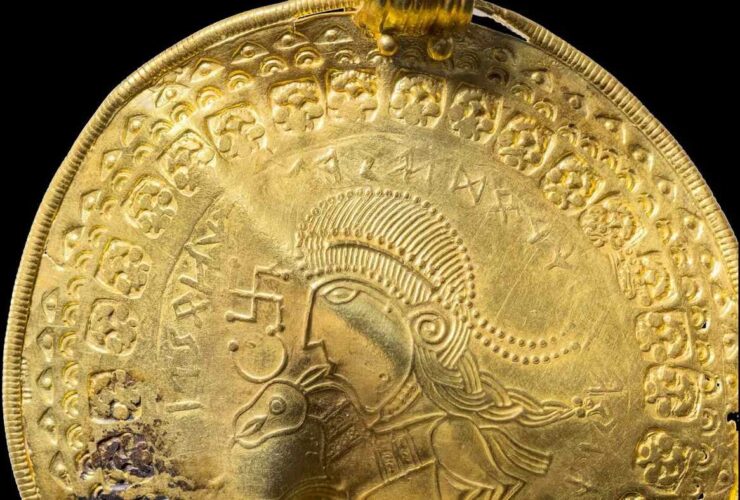Uncovered in 2020, a gold necklace was re-examined and found to bear the inscription “He is Odin’s man”. This necklace is the oldest object ever found bearing the name of the Norse chief god (Odin).
The pendant, which dates to the 400s CE, the century of the fall of the Roman Empire, is thought to have belonged to a leader of some kind because gold represents status and Odin was the god of kings.
The king of the gods and the god of kings was Odin, also referred to as Wotan or Woden, the origin of all these names is the Germanic *Wōđanaz. In many Germanic languages, including English, ‘Wednesday’ is named after this god. He was the supreme figure in the Northern European pantheon, revered by the Anglo-Saxons, Germanic tribes, Celts, and, most notably, the Vikings. He was also the god of runes, wisdom, magic, and death.
Near the village of Vindelev, on Denmark‘s Jutland Peninsula, this pendant, officially called a bracteate, was discovered in a gold treasure in 2020. The Odin’s name inscription is 150 years older than the previous earliest reference discovered.
A bracteate is a small, round, thin gold plate provided with a ring so it can be attached to a string or chain. Bracteate were a common type of jewelry in Iron Age Scandinavia and more than 1,000 artifacts bearing inscriptions such as those found at Vindelev. For instance, it was discovered that the stamping die used on the “Odin’s man” bracteate was also used on another bracteate discovered in 1852.
Lisbeth Imer, a runologist and writing expert at the National Museum of Denmark, said to Live Science: “So, the National Museum has been in possession of an inscription with the word Odin on it for 170 years—but we didn’t know until recently.”
“Odin’s man” is thought to have been called Jaga, or Jagaz—a name that differs from the names carved into the hundreds of Viking-era runestones that dot Scandinavia, or that appear in Norwegian or Icelandic sagas, suggesting he, and potentially Odin worship, came from further inland.
Imer said: “This is absolutely amazing. It means that Norse mythology can now be dated back to the early fifth century.”
The inscription is written in runes, an ancient alphabet used in Scandinavia and Germania during the Iron Age. Every few centuries, the runic language underwent changes, and many terms became obsolete. The National Museum of Denmark’s deciphering team thinks the finding will change how early runic language is studied and could lead to entirely new interpretations of previously unrecognized passages.
Since Odin appears so frequently in Norse interpretations of biblical stories like Genesis, Exodus, and Revelations, the team currently believes that this suggests the whole Norse canon is backdated along with Odin. In other words, very few of the other tales could be recounted without him.
